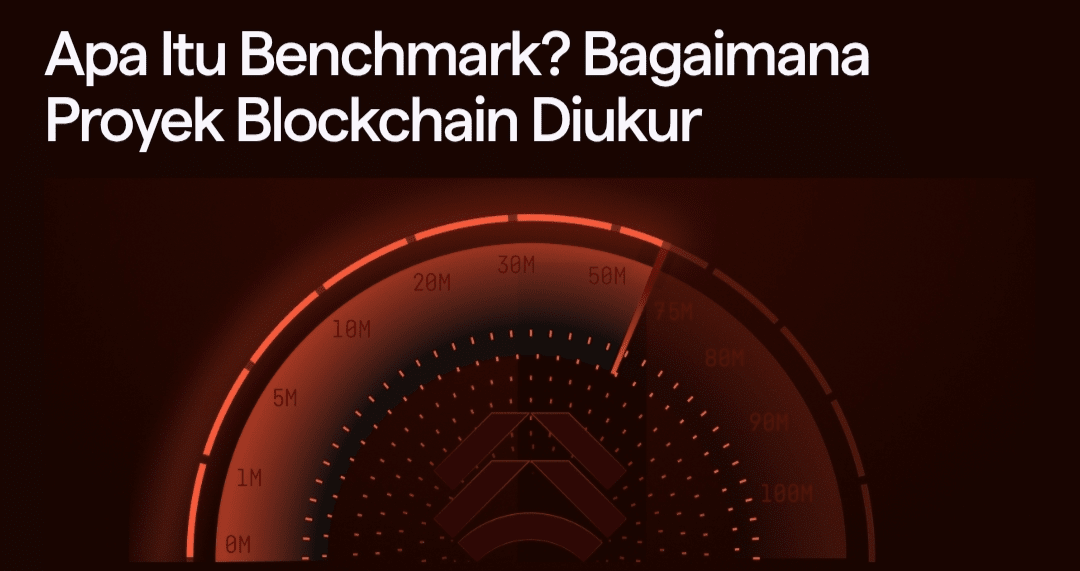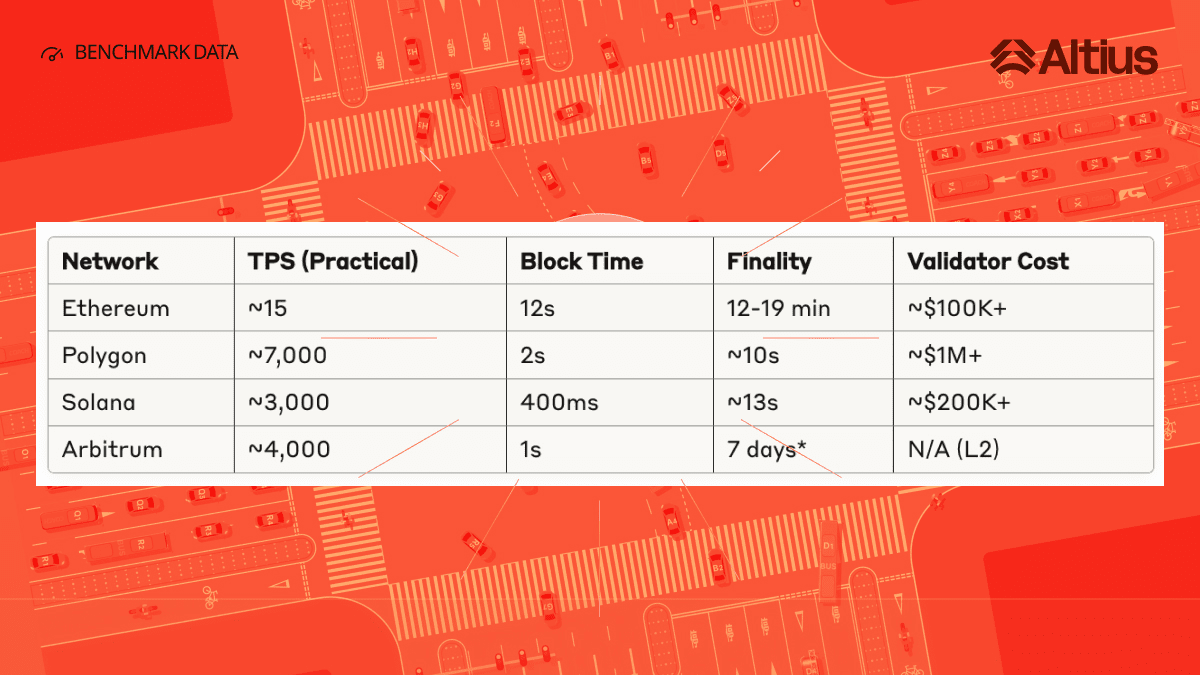
In blockchain, numbers are everywhere — but are those numbers good? You will see projects boasting 100,000 TPS, others claiming lightning-fast finality, and DeFi protocols advertising jaw-dropping APYs. However, without the right context, these numbers are just marketing noise competing for your attention in an increasingly crowded space.
As the CTO at Altius Labs, I have spent years building high-performance systems, first at Hudson River Trading where microseconds matter, and now in blockchain where the stakes are just as high but the metrics are much more complex. Here’s the reality: benchmarks are crucial for understanding performance and progress in Web3. These benchmarks distinguish between making the right decisions and being consumed by marketing promotions.
This is what benchmarking means in Web3, why benchmarks are more important than ever, and how smart teams use them to build better products, make strategic decisions, and stay competitive in a rapidly evolving market.
What is a Benchmark?
A benchmark is a reference point for measuring performance. Think of it as a standard benchmark that allows you to compare different systems, track progress over time, and identify areas for improvement. In its simplest form, a benchmark answers the question: 'How well does this system perform compared to our expectations or the achievements of others?'
In traditional sectors, benchmarks are ubiquitous and established. The S&P 500 serves as a benchmark for stock market performance. Intel's processor benchmarks help you choose among various CPUs. Website loading time is measured based on the three-second rule that determines user retention.
However, this is where blockchain becomes interesting — and complicated. Traditional benchmarks usually measure one system in isolation. Database benchmarks test query performance. Web server benchmarks measure request handling. In contrast, blockchain benchmarks must consider distributed systems, economic incentives, security trade-offs, and user behavior simultaneously.
When we talk about benchmarking in crypto and blockchain projects, we are essentially asking: 'How does the performance of this decentralized system across various dimensions compare to similar systems, its past performance, and user expectations?' The answers encompass everything from raw technical metrics like transactions per second to economic indicators like total value locked, to social metrics like developer activity and community engagement.
Why Benchmarks Matter in Blockchain
Fast-Moving Markets — Benchmarks Help You Track Competitiveness
The blockchain world is evolving rapidly. New Layer 2 solutions are launched every month, DeFi protocols iterate weekly, and consensus mechanisms continue to evolve. Without benchmarks, you will be adrift in a competitive landscape where yesterday's innovations become tomorrow's benchmarks.
I have seen projects that six months ago were leading their field suddenly fall behind because they were not tracking the right metrics. Successful teams are those who benchmark diligently — not just against their current position but also against market direction.
Benchmarks Keep Projects Honest: Avoid Inflated Metrics
Here’s the bitter reality from my experience in traditional finance and crypto: teams naturally tend to gravitate towards metrics that make them look good. In HFT, everyone focuses on latency improvements while ignoring risk-adjusted returns. In crypto, projects are obsessed with TPS while neglecting real-world usability or economic sustainability.
Proper benchmarking drives intellectual honesty. This benchmarking raises uncomfortable questions like: 'Sure, your test network can handle 50,000 TPS, but what happens under real network conditions with real economic incentives?' Projects that survive and thrive are those willing to benchmark against meaningful metrics, sometimes less flattering.
Investors and Users Care About Performance Compared to Competitors
Whether you are raising capital or attracting users, stakeholders not only care about your metrics — they care about how you compare to other alternatives. VCs evaluating blockchain infrastructure look at benchmarks across performance, security, and adoption metrics. Users choose DeFi protocols based on comparative outcomes, security track records, and user experience benchmarks.
Consider this example: If your L2 claims 'fast,' how many TPS is that based on? Fast compared to what? 15 TPS of Ethereum mainnet? 7,000 TPS of Polygon? 65,000 theoretical TPS of Solana? Without benchmark context, 'fast' is just a meaningless marketing term.
General Blockchain Benchmarks
Understanding the blockchain benchmarking landscape requires a review of several interconnected categories. Each category has distinct objectives and appeals to different stakeholders.
Network Performance: Technical Foundations
Transactions Per Second (TPS) remains the most cited benchmark but is also the most misunderstood. Actual TPS should account for transaction complexity, network conditions, and sustainable performance over time, not peak theoretical throughput.
Block time measures how often new blocks are produced. Faster is not always better — shorter block times can increase orphan rates (stale blocks) and network instability.
Gas fees and transaction costs have become important benchmarks for user experience. Average transaction fees on Ethereum vary greatly based on network congestion and can determine the success or failure of user adoption.
Finality time measures how long until a transaction is considered irreversible. In traditional finance, transaction settlement can take days. In blockchain, finality time ranges from seconds to hours, depending on the consensus mechanism.
Health Protocol: Economic and Security Indicators
Total Value Locked (TVL) has become the de facto benchmark for the success of DeFi protocols. Although not perfect, TVL provides a proxy for user trust and protocol utility. However, it is important to differentiate between legitimate TVL growth and artificial inflation through governance tokens or liquidity mining programs.
Staking participation rates indicate network security and community engagement. Higher participation usually means better security but can also indicate centralization if only a few large validators dominate.
Validator Distribution and decentralization metrics are crucial for long-term sustainability. The Nakamoto coefficient provides one framework for measuring how many entities control the majority of the network.

Adoption: User and Developer Metrics
Daily Active Wallets and unique addresses provide insights into real usage versus speculative trading. Projects with high transaction volumes but low unique addresses may indicate bot activity or wash trading.
Developer Activity Metrics from platforms like GitHub and Electric Capital’s developer reports indicate ecosystem health and long-term viability. Networks with declining developer activity often struggle with innovation and security updates.
User Retention Rate helps differentiate between users who are one-time attracted by incentives and those who genuinely fit the product-market match. DeFi protocols especially struggle with user retention after liquidity mining rewards end.
Financial Performance: Returns and Yield
Annual Percentage Yield (APY) for staking and liquidity provisioning helps users compare opportunities across different protocols. However, sustainable yields require careful analysis of the underlying revenue sources and tokenomics.
Liquidity Pool Outcomes and trading fees become benchmarks in DeFi protocol revenue generation. Protocols with consistently high fees often demonstrate strong product-market fit and sustainable business models.
Risk-Adjusted Returns account for smart contract risks, impermanent loss, and protocol governance risks. Raw yields without risk adjustments can be misleading.
Security Benchmarks: Trust and Reliability
Bug Bounty payments and security audit outcomes provide objective measures of a protocol's security investment and vulnerability discoveries. Protocols with comprehensive bug bounty programs often have fewer critical vulnerabilities in production.
Time Since Last Critical Response Bug and incident response times help measure protocol maturity and team competency. How quickly a team identifies, patches, and communicates security issues says a lot about their operational capabilities.
The availability and cost of Insurance Coverage can serve as a market-based security benchmark. If professional risk assessors won't insure a protocol, that's a significant signal.
How Altius Labs Helps Teams Benchmark Better
At Altius Labs, we learned that effective benchmarking requires more than just collecting numbers — benchmarking requires understanding context, avoiding common pitfalls, and focusing on metrics that truly drive business outcomes.
Using Reliable and Comparable Data Sources
The quality of your benchmarking relies solely on your data sources. We have seen teams make critical decisions based on misleading or incomparable data. For example, comparing testnet performance with mainnet results, or using peak theoretical throughput instead of sustainable real-world performance.
Our approach emphasizes validated performance data and production standards. When we benchmark blockchain execution performance, we use real transaction patterns, actual network conditions, and comparable hardware configurations. This assures teams that performance improvements will yield real benefits for users.
Avoiding Misleading Comparisons
One of the biggest mistakes in blockchain benchmarking is comparing apples to oranges. Simple token transfers require vastly different resources compared to complex DeFi exchanges involving multiple smart contracts and cross-chain bridges.
We help teams build a fair comparison framework that takes into account:
Transaction complexity and computational requirements
Network conditions and congestion patterns
Economic incentives and validator behavior
User experience factors go beyond raw performance metrics
Tracking Historical vs. Industry vs. Competitor Benchmarks
Effective benchmarking requires three comparison points: your current position, the current industry position, and your competitors' positions. We help teams build monitoring systems that track performance across all three dimensions.
Historical benchmarks show your performance improvement over time. Industry benchmarks show how your performance compares to ecosystem standards. Competitor benchmarks show your relative position in strategic decision-making.
Providing Insights, Not Just Raw Numbers
The most common mistake in benchmarking is gathering metrics without actionable insights. Raw numbers do not determine decisions — context and interpretation do.
Our infrastructure work focuses on delivering actionable insights for teams. Instead of merely reporting 'Your TPS is down 15%,' we provide analyses like 'TPS dropped due to increased transaction complexity from new DeFi integrations, but revenue per transaction increased 40%, indicating healthy user adoption.'
At Altius Labs, we build infrastructure so that these insights can be accessible to every blockchain project. Our modular execution stack not only enhances performance but also provides the visibility and benchmarking capabilities teams need to understand and optimize their systems continuously.
Currently, we are collaborating with various partners to validate our approach through rigorous benchmarking and real-world testing. Instead of rushing to market with impressive theoretical numbers, we take the time to ensure our performance improvements yield measurable benefits for users and developers.
Road Ahead: Benchmarks for Success
The blockchain industry is maturing, and so are our benchmarking practices. The era of competition relying solely on theoretical TPS numbers is over. Users, developers, and investors are increasingly demanding comprehensive benchmarking that accounts for security, usability, sustainability, and real-world performance.
The most successful projects in the next phase of Web3 are those that benchmark honestly, comprehensively, and sustainably. They will track not only what makes them look good but also what truly matters to users and the broader ecosystem.
Whether you are building a new Layer 2, launching a DeFi protocol, or evaluating blockchain infrastructure for your application, remember that benchmarks are tools for improvement, not just marketing. The most important numbers are those that help you build better products and serve users more effectively.
While continuing to build infrastructure for the future of Web3 at Altius Labs, we are committed to not only advancing blockchain performance but also benchmarking practices that help the entire ecosystem make better decisions. Because in a world filled with numbers, the important numbers are those that help us build a better, more accessible, and more sustainable decentralized future.

